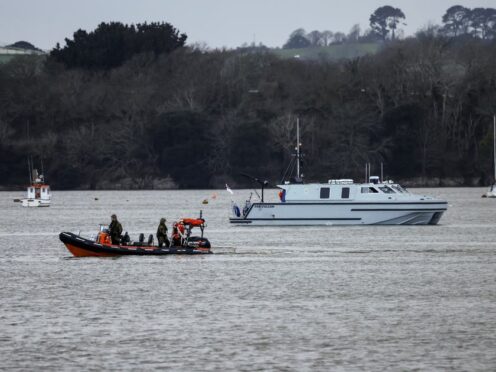The Ministry of Defence (MoD) has confirmed a Second World War bomb that forced thousands to evacuate in Plymouth has been detonated at sea.
An MoD spokeswoman told the PA news agency the bomb had been “detonated successfully at 9.51pm”.
The 500kg explosive was discovered in a back garden on Tuesday, which prompted “one of the largest UK peacetime evacuation operations”, according to the MoD.
Around 30 of the armed forces’ most experienced bomb disposal specialists had worked around the clock to assess the condition of the device since it was discovered in St Michael Avenue in the Keyham area of Plymouth.
On Friday, a military convoy carried the unexploded bomb on the back of a truck from the garden through a densely populated residential area to Torpoint Ferry slipway, where it was taken out to sea.

Around 10,320 people and 1,219 properties were affected by the 300m cordon placed along the route.
The MoD said the munition, identified as an air-dropped German bomb from the Second World War – designated SC-500 – was assessed as posing a significant risk to public safety with people living within the cordon evacuated.

More than 100 personnel from the British Army and Royal Navy, including bomb disposal experts, were involved in the complex operation along with Plymouth City Council officials, Devon and Somerset Fire and Rescue Service, Devon and Cornwall Police and members of the armed forces, to ensure the device was removed and people were safe.
Lt Colonel Rob Swan, who was at the scene, explained before the detonation that the bomb would be taken to a depth of at least 14 metres before a diver would place a donor charge on the bomb to ignite the explosive.
On Friday at 5.32pm, town hall chiefs declared the operation a “success” telling residents “you can now return to your homes in Keyham”.

Tudor Evans, the leader of Plymouth City Council, said: “I think it is fair to say that the last few days will go down in history for Plymouth.”
Defence Secretary Grant Shapps thanked the personnel who had been involved in the “highly complex operation”.
Thank you to all those personnel who’ve worked day & night to keep people safe and remove from harm’s way the unexploded bomb found in Plymouth.
The success of this operation is a testament to the skill and fortitude with which our Armed Forces serve when faced with high risks. pic.twitter.com/GqzUflH8rC
— Rt Hon Grant Shapps MP (@grantshapps) February 23, 2024
Mr Shapps said: “I would like to express my thanks to all our personnel involved in this highly complex operation, who worked both night and day this week to keep the public safe and minimise the risk of damage, as well as the public for their patience and cooperation.
“The success of this operation is testament to the level of skill and expertise across our armed forces, as well as the bravery and fortitude of our personnel when faced with high-risk situations and working under extreme pressure.”
